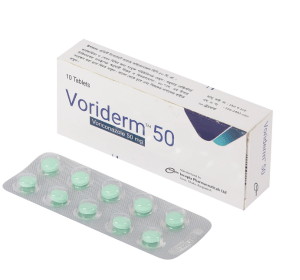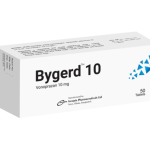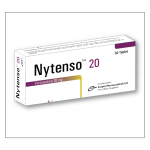Voriderm(Voriconazole)
Therapeutic Group: Systemic Anti-Fungal Agent

Presentation
VoridermTM 50 mg tablet: Each tablet contains Voriconazole BP 50 mg.
VoridermTM 200 mg tablet: Each tablet contains Voriconazole BP 200 mg.
VoridermTM IV Injection: Each vial contains Voriconazole BP 200 mg as lyophilized cake or powder.
Description
Voriconazole is an azole antifungal agent. The primary mode of action of Voriconazole is the inhibition of fungal cytochrome P-450-mediated 14 alpha-lanosterol demethylation, an essential step in fungal ergosterol biosynthesis. The accumulation of 14 alpha-methyl sterols correlates with the subsequent loss of ergosterol in the fungal cell wall and may be responsible for the antifungal activity of Voriconazole. Voriconazole has been shown to be more selective for fungal cytochrome P-450 enzymes than for various mammalian cytochrome P-450 enzyme systems.
Indications
Voriconazole is an antifungal indicated for use in the treatment of:
• Invasive Aspergillosis
• Candidemia (nonneutropenics) and disseminated candidiasis in skin, abdomen, kidney, bladder wall, and wounds
• Esophageal candidiasis
• Serious infections caused by Scedosporium apiospermum and Fusarium species including Fusarium solani, in patients intolerant of, or refractory to, other therapy.
Dosage & Administration
Voriconazole Tablet is to be taken at least one hour before or one hour following a meal.
For Patients 40 kg or above:
Loading Dose: 400 mg twice daily (for the first 24 hours)
Maintenance Dose: 200 mg twice daily (from the second day)
For Patients less than 40 kg:
Loading Dose: 200 mg twice daily (for the first 24 hours)
Maintenance Dose: 100 mg or 150 mg twice daily (from the second day)
Treatment duration depends upon patients’ clinical and mycological response.
Dose adjustment
If patient’s response is inadequate, the oral maintenance dose may be increased from 200 mg every 12 hours to 300 mg every 12 hours and for adult patients weighing less than 40 kg, the oral maintenance dose may be increased from 100 mg every 12 hours to 150 mg every 12 hours. If patient is unable to tolerate 300 mg orally every 12 hours, the oral maintenance dose may be reduced by 50 mg steps to a minimum of 200 mg every 12
hours (or to 100 mg every 12 hours for adult patients weighing less than 40 kg).
Patients with hepatic impairment: Only the maintenance dose is recommended to be halved in adult patients with mild to moderate hepatic cirrhosis (Child-Pugh Class A and B).
Patients with renal impairment: No adjustment is necessary for oral dosing in patients with mild to severe renal impairment.
Co-administered with Phenytoin or Efavirenz: Maintenance dose of Voriconazole should be increased when co-administered with Phenytoin or Efavirenz.
Pediatric use
Safety and effectiveness in pediatric patients below the age of 2 years has not been established. Therefore, Voriconazole is not recommended for pediatric patients less than 2 years of age.
Geriatric Use
The overall safety profile of the elderly patients was similar to that of the young so no dosage adjustment is recommended.
Side Effects
Most common adverse reactions are visual disturbances, fever, nausea, rash, vomiting, chills, headache, liver function test abnormality, tachycardia & hallucinations.
Precautions
Liver function should be evaluated at start of and during Voriconazole therapy. Patients with Hereditary Galactose Intolerance, Lapp Lactase deficiency or glucose-galactose malabsorption should not use Voriconazole. Patients with proarrhythmic conditions should use with caution.
It should be discontinued for exfoliative cutaneous reactions or phototoxicity. Fluorosis and periostitis can occur with long-term Voriconazole therapy.
Use in Pregnancy & Lactation
Pregnancy Category D: Voriconazole can cause fetal harm when administered to a pregnant woman. The excretion of Voriconazole in breast milk has not been investigated. Voriconazole should not be used by nursing mothers unless the benefit clearly outweighs the risk.
Drug Interaction
• CYP3A4, CYP2C9, and CYP2C19 inhibitors and inducers: Adjust Voriconazole dosage and monitor for adverse reactions or lack of efficacy
• Voriconazole may increase the concentrations and activity of drugs that are CYP3A4, CYP2C9 and CYP2C19 substrates. Reduce dosage of these other drugs and monitor for adverse reactions
• Phenytoin or Efavirenz: For co-administration, increase maintenance oral and intravenous dosage of Voriconazole
Storage
For Voriderm IV: Do not store above 30°C. Keep away from light and out of the reach of children.
After reconstitution reconstituted solution can be stored for 24 hours at 2-8 C.
Commercial Pack
VoridermTM 50 mg tablet: Each box contains 1 blister strip of 10 tablets.
VoridermTM 200 mg tablet: Each box contains 1 blister strip of 10 tablets.
VoridermTM IV Injection: Each box contains a blister pack containing one vial of 200 mg Voriconazole as lyophilized cake or powder and two ampoules of 10 ml Water for injection and a complimentary pouch comprising one 20 ml sterile disposable syringe, one butterfly needle, one alcohol pad and one first aid bandage.


